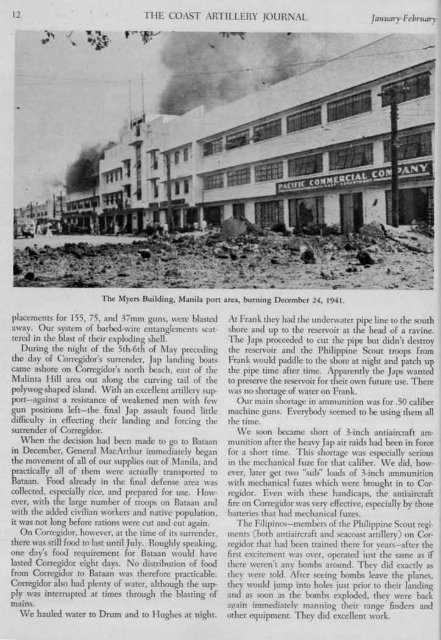January-February - Air Defense Artillery
January-February - Air Defense Artillery
January-February - Air Defense Artillery
Create successful ePaper yourself
Turn your PDF publications into a flip-book with our unique Google optimized e-Paper software.
12<br />
"<br />
..'<br />
THE COAST ARTILLERY JOLIRNAL<br />
........... ~<br />
'-<br />
-<br />
The Myers Building, Manila port area, burning December 24, 1941.<br />
placements for 155, 75, and 37mm guns, were blasted<br />
away. Our system of barbed-wire entanglements scattered<br />
in the blast of their exploding shell.<br />
During the night of the 5th-6th of May preceding<br />
the day of Corregidor's surrender, Jap landing boats<br />
came ashore on Corregidor's north beach, east of the<br />
Malinta Hill area out along the curving tail of the<br />
polywog-shaped island. \\Tith an excellent artillery support-against<br />
a resistance of weakened men with few<br />
gun positions left-the final Jap assault found little<br />
difficulty in effecting their landing and forcing the<br />
surrender of Corregidor.<br />
\\Then the decision had been made to go to Bataan<br />
in December, General MacArthur immediately began<br />
the movement of all of our supplies out of Manila, and<br />
practically all of them were actually transported to<br />
Bataan. Food already in the final defense area was<br />
collected, especiaily rice, and prepared for use. However,<br />
with the large number of troops on Bataan and<br />
with the added civilian workers and native population,<br />
it was not long before rations were cut and cut again.<br />
On Corregidor, however, at the time of its surrender,<br />
there was still food to last until July. Roughly speaking,<br />
one day's food requirement for Bataan would have<br />
lasted Corregidor eight days. No distribution of food<br />
from Corregidor to Bataan was therefore practicable.<br />
Corregidor also had plenty of water, although the supply<br />
was interrupted at times through the blasting of<br />
mains.<br />
V\Te hauled water to Drum and to Hughes at night.<br />
Jmllulr)'- Fe brzU1T)<br />
At Frank they had the underwater pipe line to the south<br />
shore and up to the reservoir at the head of a ravine.<br />
The Japs proceeded to cut the pipe but didn't destroy<br />
the reservoir and the Philippine Scout troops from<br />
Frank would paddle to the shore at night and patch up<br />
the pipe time after time. Apparently the Japs wanted<br />
to preserve the reservoir for their own future use. There<br />
was no shortage of water on Frank.<br />
Our main shortage in ammunition was for .50 caliber<br />
machine guns. Everybody seemed to be using them all<br />
the time.<br />
\Ve soon became short of 3-inch antiaircraft ammunition<br />
after the heavy Jap air raids had been in force<br />
for a short time. This shortage was especially serious<br />
in the mechanical fuze for that caliber. \rYe did, however,<br />
later get two "sub" loads of 3-inch ammunition<br />
with mechanical fuzes which were brought in to Corregidor.<br />
Even with these handicaps, the antiaircraft<br />
fire on Corregidor was very effective, especially by those<br />
batteries that had mechanical fuzes.<br />
The Filipinos-members of the Philippine Scout regiments<br />
(both antiaircraft and seacoast artillerv) on Corregidor<br />
that had been trained there for year;-after the<br />
first excitement was over, operated just the same as if<br />
there weren't any bombs around. They did exactly as<br />
they were told. After seeing bombs leave the planes,<br />
they would jump into holes just prior to their landing<br />
and as soon as the bombs exploded, they were back<br />
aQain immediatel" manning their range finders and<br />
other equipment. They did excellent work.
















